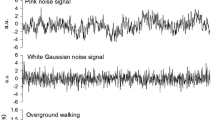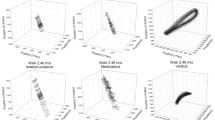Abstract
The Wolf’s (W-algorithm) and Rosenstein’s (R-algorithm) algorithms have been used to quantify local dynamic stability (largest Lyapunov exponent, λ 1) in gait, with prevalence of the latter one that is considered more suitable for small data sets. However, such a claim has never been investigated. To address it, the λ 1 of the Lorenz attractor was estimated using small data sets and varied delays and embedding dimensions. Overall, the λ 1 estimates from the R-algorithm got closer to the theoretical exponent than those from the W-algorithm. The W-algorithm also overestimated λ 1 while the R-algorithm underestimated it, overlooking the attractor convergences and divergences, respectively. Local dynamic stability was then examined from 1-, 2- and 3-min long gait time series of younger (YA) and older adults (OA). The OA were found more locally unstable than the YA regardless of time series length with the W-algorithm but only for the longest time series with the R-algorithm. The lack of sensitivity to capture age-related decline in local dynamic stability from shorter time series is proposed to result from a drawback of the R-algorithm that overlooks the expansion of the attractor trajectories. The W-algorithm is advocated for use when examining local dynamic stability with small gait data sets.




Similar content being viewed by others
References
Abarbanel, H. D. I., R. Brown, and J. B. Kadtke. Prediction in chaotic nonlinear systems: methods for time series with broadband Fourier spectra. Phys. Rev. A 41:1782–1807, 1990.
Bruijn, S. M., W. R. Ten Kate, G. S. Faber, O. G. Meijer, P. J. Beek, and J. H. van Dieën. Estimating dynamic gait stability using data from non-aligned inertial sensors. Ann. Biomed. Eng. 38:2588–2593, 2010.
Bruijn, S. M., J. H. van Dieën, O. G. Meijer, and P. J. Beek. Is slow walking more stable? J. Biomech. 42:1506–1512, 2009.
Bruijn, S. M., J. H. van Dieën, O. G. Meijer, and P. J. Beek. Statistical precision and sensitivity of measures of dynamic gait stability. J. Neurosci. Methods 178:327–333, 2009.
Buzzi, U. H., N. Stergiou, M. J. Kurz, P. A. Hageman, and J. Heidel. Nonlinear dynamics indicates aging affects variability during gait. Clin. Biomech. 18:435–443, 2003.
Cappozzo, A., F. Catani, A. Leardini, M. G. Benedetti, and U. Della Croce. Position and orientation in space of bones during movement: experimental artefacts. Clin. Biomech. 11:90–100, 1996.
Casdagli, M. Nonlinear prediction of chaotic time series. Physica D 35:335–356, 1989.
Dingwell, J. B., and J. P. Cusumano. Nonlinear time series analysis of normal and pathological human walking. Chaos 10:848–863, 2000.
Dingwell, J. B., J. P. Cusumano, D. Sternad, and P. R. Cavanagh. Slower speeds in neuropathic patients lead to improved local dynamic stability of continuous overground walking. J. Biomech. 33:1269–1277, 2000.
Dingwell, J. B., J. P. Cusumano, D. Sternad, and P. R. Cavanagh. Local dynamic stability versus kinematic variability of continuous overground and treadmill walking. J. Biomech. Eng. 123:27–32, 2001.
Dingwell, J. B., and L. C. Marin. Kinematic variability and local dynamic stability of upper body motions when walking at different speeds. J. Biomech. 39:444–452, 2006.
Eckmann, J. P., S. O. Kamphorst, D. Ruelle, and S. Ciliberto. Lyapunov exponents from time series. Phys. Rev. A 34:4971–4979, 1986.
Eckmann, J. P., and D. Ruelle. Ergodic theory of chaos and strange attractors. Rev. Mod. Phys. 57:617–656, 1985.
Eckmann, J. P., and D. Ruelle. Fundamental limitations for estimating dimensions and Lyapunov exponents in dynamical systems. Physica D 56:185–187, 1992.
Ellner, S., A. R. Gallant, D. McCaffrey, and D. Nychka. Convergence rates and data requirements for Jacobian-based estimates of Lyapunov exponents from data. Phys. Lett. A 153:357–363, 1991.
England, S. A., and K. P. Granata. The influence of gait speed on local dynamic stability of walking. Gait Posture 25:172–178, 2007.
Fraser, A. M., and H. L. Swinney. Independent coordinates for strange attractors from mutual information. Phys. Rev. A 33:1134–1140, 1986.
Gates, D. H., and J. B. Dingwell. Comparison of different state space definitions for local dynamic stability analyses. J. Biomech. 42:1345–1349, 2009.
Jordan, K., J. H. Challis, and K. M. Newell. Walking speed influences on gait cycle variability. Gait Posture 26:128–134, 2007.
Kang, H. G., and J. B. Dingwell. Intra-session reliability of local dynamic stability of walking. Gait Posture 24:386–390, 2006.
Kang, H. G., and J. B. Dingwell. Effects of walking speed, strength and range of motion on gait stability in healthy older adults. J. Biomech. 41:2899–2905, 2008.
Kang, H. G., and J. B. Dingwell. Dynamic stability of superior vs. inferior segments during walking in young and older adults. Gait Posture 30:260–263, 2009.
Kantz, H., and S. Schreiber. Nonlinear Time Series Analysis (2nd ed.). Cambridge, UK: Cambridge University Press, 2004.
Kennel, M. B., R. Brown, and H. D. I. Abarbanel. Determining embedding dimension for phase space-reconstruction using a geometrical construction. Phys. Rev. A 45:3403–3411, 1992.
Kyvelidou, A., M. J. Kurz, J. L. Ehlers, and N. Stergiou. Aging and partial body weight support affects gait variability. J. Neuroeng. Rehabil. 19:5–22, 2008.
Mees, A. I., and K. Judd. Dangers of geometric filtering. Physica D 68:427–436, 1993.
Nigg, B. M., G. K. Cole, and W. Nachbauer. Effects of arch height of the foot on angular motion of the lower extremities in running. J. Biomech. 26:909–916, 1993.
Rosenstein, M. T., J. J. Collins, and C. J. De Luca. A practical method for calculating largest Lyapunov exponents from small data sets. Physica D 65:117–134, 1993.
Sano, M., and Y. Sawada. Measurement of the Lyapunov spectrum from a chaotic time series. Phys. Rev. Lett. 55:1082–1085, 1985.
Strogatz, S. H. Nonlinear Dynamics and Chaos: With Applications to Physics, Biology, Chemistry, and Engineering. New York, NY: Addison-Wesley, 1994.
Takens, F. Detecting strange attractors in turbulence. In: Dynamical Systems and Turbulence, Warwick 1980, Vol. 898, edited by D. Rand, and L. S. Young. Berlin: Springer, 1981, pp. 366–381.
Vaughan, C., B. Davis, and J. O’Connor. Dynamics of Human Gait. Cape Town, South Africa: Kiboho Publishers, 1999.
Wolf, A., J. B. Swift, H. L. Swinney, and J. A. Vastano. Determining Lyapunov exponents from a time series. Physica D 16:285–317, 1985.
Acknowledgments
This research was supported by National Institutes of Health (1K99AG033684) and National Institute on Disability and Rehabilitation Research (H133G080023) grants. The authors thank Dr. M. J. Kurz for his technical assistance.
Conflict of interest
The authors disclose any financial and personal relationships with other people or organizations that could inappropriately influenced (bias) this work.
Author information
Authors and Affiliations
Corresponding author
Additional information
Associate Editor Catherine Disselhorst-Klug oversaw the review of this article.
Rights and permissions
About this article
Cite this article
Cignetti, F., Decker, L.M. & Stergiou, N. Sensitivity of the Wolf’s and Rosenstein’s Algorithms to Evaluate Local Dynamic Stability from Small Gait Data Sets. Ann Biomed Eng 40, 1122–1130 (2012). https://doi.org/10.1007/s10439-011-0474-3
Received:
Accepted:
Published:
Issue Date:
DOI: https://doi.org/10.1007/s10439-011-0474-3




